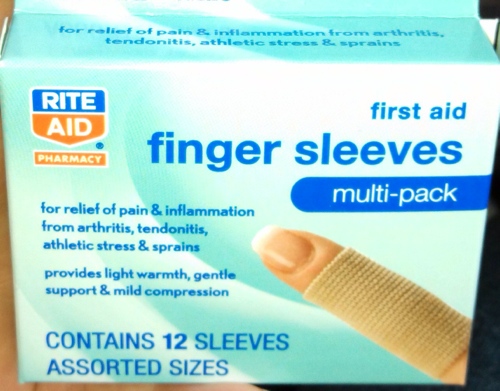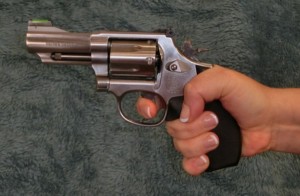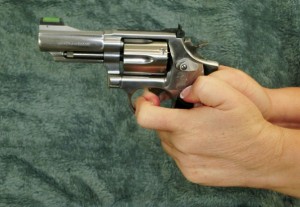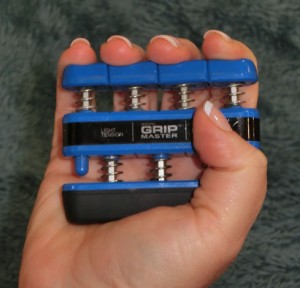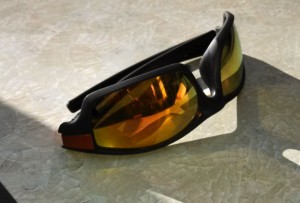Especially during the holidays and as we begin the new year, when someone asks what I do for a living and I reply that I teach self-defense classes, some people recoil in apparent horror. “That’s such a downer!” one woman recently wailed at me. “What a horrible place to live. How can you stand it?”
Her question hurt my heart, because it meant that she thinks of self-defense as a negative subject. It meant she believed that knowing ways to protect yourself from crime might drive you toward a damaging and maybe even a destructive place in your life.
That’s not how I see it.
My world is full of joy, and I find the things I do for a living both life-affirming and positive. In my world, mastering the art of using the handgun feels like a happy process, even when it takes work to climb the steep new-learning curve. The physical act of firing the gun can feel awesome. Growing in skill so that you can hit the target when you want to can make you feel like a million bucks. But the biggest joy of all? That’s the confidence that comes building a trustworthy ability to take care of yourself and the people you love.
The Beginner’s Grin
Let’s start with the first time out the gate. Did you ever see the look on a first-time shooter’s face? Most of the time, you see an amazing grin that spreads from one ear to the other, with crinkles at the eye corners and a big flash of teeth. Some people literally shout for joy with the first shot: “Whooooo! What a rush!”
Watching that look grow, having a part of making it happen… that’s a privilege beyond compare. Although I don’t often work with first-time shooters anymore, I still love to watch over newbies and help keep them safe whenever I can.
Did you know you can see also that same amazing look on the face of an experienced shooter? It’s a fact! In my classes, experienced shooters get that same grin all over again as their skills develop and they grow in confidence. Watching someone struggle to learn something new, and then nail it and react to the rush when they do – there’s just nothing like it. It’s even more cool when my advanced students use skills they’ve learned from me to turn around and work with their own beginning students, setting up the process all over again. It’s a never-ending cycle of joy.
Talking about that new shooter’s grin, that’s even more amazing and fun when the new shooter is a child. Taking kids out to shoot – at the appropriate ages, with appropriate preparation and proper safety gear – is a rush beyond compare. Believe me, as I wrote this wonderful old article about taking my little guys to the range, I was smiling the whole time with fond nostalgia. You should have seen the look on their little faces when that first vegetable exploded!
Of course, I’m hardly the only parent who has ever discovered how much fun it is to help a youngster learn how to shoot. The beautiful truth is, you don’t have to be some eagle-eyed, highly trained ninja to enjoy an afternoon plinking safely with your kid. Anyone with a modicum of good sense and a little knowledge can do it. And there’s just not a whole lot more fun you can have with your kids than to help them learn something so exciting, so life-affirming, so positive as the shooting sports. That those skills might someday be used to protect themselves or the people they love – well, that’s just icing on the cake.
What About Crime?
This wouldn’t be an honest article if I didn’t tell you that sometimes my job involves learning about some very grim events, and of course sometimes I have to dig pretty deep into those events in order to understand them better. When a violent crime happens, it’s never a happy thing for anyone. It’s ugly and messy and frightening and depressing.
How could there be any joy in that?
There is some. But it’s a sober kind of joy, and it works like this. When I need to learn more about a frightening event, or when I have to study the details of violent crimes so that I understand how criminals approach their intended prey, I can still choose the attitude I bring to that study. I could let myself wallow in negative emotions. That would be easy to do, because events themselves can be awful and my heart always goes out to the innocent victims. But that’s not where I live. It’s not where I choose to live.
When I learn about a crime, I’m not just another gawker, staring in fascination at someone else’s pain. That would be ghoulish and awful! But because rubbernecking is not my purpose, I’m don’t find myself mired in grief or fear or any other negative emotion when I watch a crime video or listen to a 9-1-1 call. Neither do I become a soul-less monster, sucking in other people’s anguish like it’s some made-for-TV movie on a lousy cable channel. Rather, my focus always centers on how I can help good people avoid similar crimes, how I can help keep my own family safe, what lessons I can teach my children and other people I love. The question at the front of my mind is always, “What can we learn, here?”
Yes, learning anything at all about violent crime can hurt sometimes. But I rejoice that it’s a discomfort I can bear. If I weren’t strong enough enough to face the distress of hearing about such things, I wouldn’t be able to help myself or anyone else escape similar troubles. To me, the only thing worse than going through a horrible life event would be going through a horrible life event that nobody learned anything from. There’s nothing I can do to make a violent crime not have happened, but I rejoice that through my work I can help redeem some of the survivors’ pain.
More than that, when I hear about violent crime, I always find myself marveling at the strength of ordinary people, at their resourcefulness, at the things they do to survive. I love to hear stories about intended victims turning the tables on their attackers. Again – the situations are often horrible, and I wouldn’t wish trials like that on my worst enemy. But I can still feel a burst of pleasure when I hear how good people survive such things, and that’s where my focus stays.
Helplessness and Confidence
A friend of mine has long struggled with fears and phobias. She’s not a shoooter and can’t stand to have guns around her, even though politically she’s “one of us.” When she hears about a criminal event, her mind immediately goes to the worst case scenario. What if it happened to her, or to her family? What could they do? How would they feel? She faces a horrifying cascade of ugly emotions, and she feels absolutely helpless in the face of those feelings. More than that, she feels helpless at the very idea of crime. She feels helpless at the thought of violence. She feels absolutely helpless in the face of trouble, so she structures her life to avoid any thought of trouble at all.
But trouble comes to everyone, sooner or later in this life. “You can’t run from trouble,” said a character in a book I read as a child. “There ain’t no place that far.” And it’s true. You’re not going to get through life unscathed. None of us will.
Does that feel like a negative thought? It doesn’t have to be. Instead of feeling discouraged or frightened by knowing how common trouble can be, we can instead take courage from knowing that others have faced violence and lived through it. It makes me stronger to know that I come from a long line of survivors, from people who suffered but who did whatever it took to live, that the people I came from all kept going. We are descended, every single one of us – you and me and that woman over there, all of us! – from a long line of strong people who didn’t curl up and die when trouble struck. They survived, and so can we. There’s power in that thought, and confidence too.
Powerlessness feels awful, but it’s not somewhere you have to live. If you don’t like feeling helpless, you can do something about that. Tell me there’s no joy in that discovery.
No Matter Who You Are…
That brings me to yet another source of constant wonder for me as a teacher, something that should bring joy to you as well. Here it is: good, ordinary people can learn better ways to protect themselves. The young mom, the single woman who travels for business, the retired couple, the middle-aged computer programmer… all of these people can come together to learn something new. With physical infirmities or in the peak of health, whatever – it doesn’t matter. Whatever your situation, there are things you can do to make your life a little safer and your loved ones a little more secure.
Self-defense doesn’t have to be a grim subject full of nasty and depressing emotions. Learning how to protect yourself from violence can be as full of meaning and relevance as you make it, as life-affirming and as positive as the outlook you yourself bring to the table.
In fact, instead of the study being a grim reminder of negative possibilities, it can become a genuinely joyful series of positive affirmations. My life is good, and worth defending! My loved ones deserve to live in peace, and by what I learn today, I can help preserve that peace for them. I can’t do everything to guarantee my own safety, but this much, I can do. I choose to carry a gun because I embrace my right to live.[ref] Not all of these will resonate with every reader, and that’s okay. Each one simply provides one possible jumping-off place of many possible. What’s your own favorite joyful affirmation of the most basic human right?[/ref]
As for me, I love helping people claim their own power, develop their own confidence, and proudly assert their absolute right not to be a victim. Helping people find and claim that place in their own lives is an awesome privilege and a joy.

